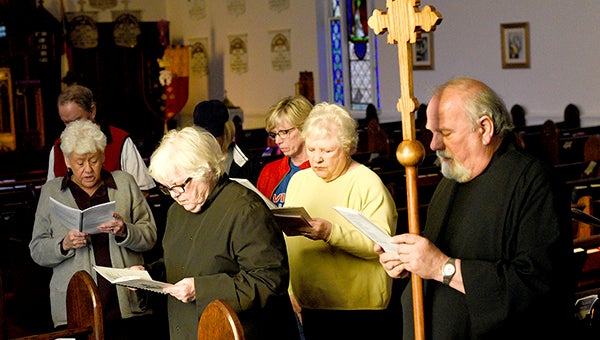RELIGION: Stations of the Cross recall Christ’s passion
Published 4:00 am Sunday, March 19, 2023

- Members of Christ Episcopal Church participate in the Stations of The Cross led by Officiant Nancy Curtis and Crucifer Jim Miller in this file photograph from March 2019.(Courtland Wells/The Vicksburg Post)
During the Lenten season, many Christians participate in a unique seasonal custom to help them further prepare for Easter by reliving Christ’s suffering and death on the cross.
The Stations of the Cross, or Way of the Cross, allow participants through prayer and scripture to follow in Christ’s steps from his trial before Pilate to his crucifixion and death.
The practice began in the Middle Ages, when Christians on pilgrimage to Jerusalem retraced Christ’s journey to Calvary, stopping at various locations along the way for reflection, prayer and meditation.
The devotion later spread to churches in Europe, where a series of 14 images or small crosses were placed on church walls and people would walk from station to station to pray and reflect on the place the image or cross represented.
The number of stations was established at 14 in the 18th century and include: Jesus is condemned, Jesus carries his cross, Jesus falls the first time, Jesus meets his mother, Simon of Cyrene helps carry the cross, Veronica wipes Jesus’ face, Jesus falls a second time, Jesus meets the women of Jerusalem, Jesus falls a third time, Jesus is stripped of his garments, Jesus is nailed to the cross, Jesus dies on the cross, his body is taken down from the cross, and his body is laid in the tomb.
In 2000, Pope John Paul II established a 15th station — the resurrection.
Both the Catholic Church and the Episcopal Church have Stations of the Cross.
Christ Episcopal Church, and St. Paul and St. Michael Catholic Church hold Stations of the Cross every Friday at 5:30 p.m. St. Mary Catholic Church has Stations of the Cross each Friday at 6 p.m. St. Paul will hold Stations of the Cross at noon on Good Friday to coincide with the time Christ was crucified.
The Rev. Rusty Vincent said the Stations of the Cross are relevant to Christians “to remember the Good Friday of what Christ did for us and then dying for us. Walking the path that Christ walked is a very important devotional reminder of the sacrifice he made.
“It’s preparation for Easter and a consistent reminder of what we’re doing for Lent — all the practices we’re doing (fasting and refraining from eating meat on Fridays).”
Vincent, who walked the Stations of the Cross in Jerusalem, said doing so gives more meaning to the custom.
“Even though the current city is built over the spot He would have walked, it gives you an idea of the path He would have walked; it was a lot of narrow streets. It’s a very lengthy walk as well so he wasn’t taking a short stroll; it’s a long walk as well, up and down hills.”
Christ Episcopal Church begins Stations of the Cross the Friday after the first Sunday in Lent and continues every Friday through the Friday before Palm Sunday, the Rev. Sam Godfrey, rector of Christ Episcopal Church, said, adding participants are processing to each station during the service.
“Everyone who desires and is able follows around (the stations),” he said. “For the most part, everybody follows around. The church is open, and anyone who wishes can join us.”
The physical movement from station to station, he said, “In a way, brings it (the passion) closer to you. We talk in the church about a sacrament being an outward and visible sign of an inward and spiritual grace.
“The same way we use water for baptism and bread and wine for Communion, in a sense, that’s what the stations do for us. It gives us a physical movement and visible imagery as we hear the story of the passion again.”
Godfrey said the Stations of the Cross inside the church were painted by church member Phyllis Blake.
“And here in the late evening with the sun coming through the stained glass, it makes for a holy time,” he added.
Godfrey said the last stations are held the Friday before Palm Sunday in the church garden.
“We have a different set of images and the version we use, there is one written by a Catholic priest, Jeff Bayhi, and sung by Aaron Neville. That’s a particularly moving piece, and there are several different versions here that we use. One of them is from the viewpoint of Mary.”






